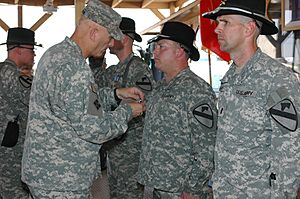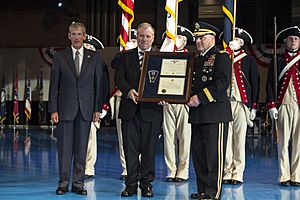Distinguished Flying Cross (United States) facts for kids
Quick facts for kids Distinguished Flying Cross |
|
|---|---|
 |
|
| Presented by |
|
The Distinguished Flying Cross (DFC) is a special military award given by the United States Armed Forces. It was created on July 2, 1926. This medal is given to people who show great bravery or amazing skill while flying an aircraft. This means doing something truly outstanding, not just a regular flight. Sometimes, military members from other friendly countries can also receive this award.
Contents
History of the Distinguished Flying Cross
The very first Distinguished Flying Cross awards were given out on May 2, 1927. President Calvin Coolidge honored ten pilots from the United States Army Air Corps. These pilots had completed a long flight across North and South America. Two of them received the award after they sadly died in a mid-air accident. At first, they only received certificates because the actual medals hadn't been made yet.
About a month later, on June 11, 1927, Charles Lindbergh received the first actual medal. He got it from President Coolidge after his famous solo flight across the Atlantic Ocean. The medal was quickly made just for this special event.
The first Navy pilot to receive the DFC was Commander Richard E. Byrd. He earned it for his flight across the Atlantic in 1927. Many famous people have received the DFC, including astronauts, actors, and even former President George H. W. Bush.
The DFC can even be given for brave actions that happened a long time ago. For example, the Wright brothers received the DFC in 1929 for their first flight in 1903. Other civilians like Amelia Earhart and Wiley Post also received it. Later, a rule was made that only military personnel could receive the award. Amelia Earhart was the first woman to receive the DFC on July 29, 1932, for her solo flight across the Atlantic.
DFC in World War I and II
The only Distinguished Flying Cross for service in World War I was given out much later, on June 14, 2017. It honored Army Captain James Ely Miller, who was the first American pilot serving with an American unit to die in that war.
During World War II, the rules for getting the medal changed a lot. It depended on where the fighting was happening and what kind of missions were flown. Sometimes, officers in the Pacific received it, while enlisted soldiers got a different medal. In Europe, some flight crews earned it for their overall performance during their missions. The rules were not always the same everywhere. Individual acts of bravery could also earn the medal. For example, George McGovern received one for safely landing his plane after an engine failed during a bombing mission. On December 28, 1944, Aleda E. Lutz became the first military woman to receive the DFC, which she received after she died.
How to Earn the Distinguished Flying Cross
The Distinguished Flying Cross was officially created by a law passed by Congress on July 2, 1926. This law states that the award is given to anyone who shows "heroism or extraordinary achievement while participating in an aerial flight." This means doing something truly special and brave while flying, beyond what is expected.
What the Medal Looks Like
The Distinguished Flying Cross was designed by Elizabeth Will and Arthur E. DuBois. The medal is made of bronze and shaped like a cross pattee. On the front, it has a four-bladed propeller. Five rays, like sunbeams, spread out from the corners of the cross. The back of the medal is blank, so the recipient's name and rank can be engraved there.
The ribbon for the medal is 1 3/8 inches wide. It has stripes of blue, white, and a small red stripe in the middle.
Special Devices on the Medal
Sometimes, extra small symbols are added to the DFC ribbon. These are called "devices."
- Oak Leaf Clusters: For the Army, Air Force, and Space Force, bronze or silver oak leaf clusters show that someone has received the DFC more than once.
- Stars: For the Navy, Marine Corps, and Coast Guard, gold and silver stars are used to show additional awards.
- "V" Device: This small "V" shape is worn on the DFC ribbon to show that the award was given for an act of valor (great bravery) during combat. The DFC can also be awarded for amazing achievements without the "V" device.
National Memorial for the DFC
In July 2014, a law was passed to make the Distinguished Flying Cross Memorial at March Field Air Museum in California a national memorial. This memorial honors all members of the U.S. Armed Forces who have shown heroism in aerial flight. President Barack Obama signed this law on July 25, 2014.
Famous People Who Received the DFC
Many well-known individuals have been awarded the Distinguished Flying Cross. Here are a few examples:
Astronauts
- Neil Armstrong: Commander of Apollo 11, the first person to walk on the Moon.
- Buzz Aldrin: Lunar Module pilot for Apollo 11, the second person to walk on the Moon.
- Michael Collins: Command module pilot for Apollo 11.
- John Glenn: One of the first American astronauts and the first American to orbit Earth. He also became a United States Senator.
- Alan Shepard: One of the original seven American astronauts and the first American in space.
- Eileen Collins: The first woman to command a Space Shuttle mission.
- Jim Lovell: Flew on Gemini 7, Gemini 12, Apollo 8, and commanded Apollo 13.
Political Figures
- George H. W. Bush: A pilot in World War II who later became President of the United States.
- John S. McCain, III: A Navy pilot and prisoner of war who later became a US Senator and presidential candidate.
- George McGovern: A bomber pilot in World War II who later became a US Senator and presidential candidate.
Civilians
- Amelia Earhart: A legendary aviator and the first woman to receive the DFC.
- Wright brothers: Aviation pioneers who made the first successful airplane flight.
- Wiley Post: The first person to fly solo around the world.
Celebrities
- James Stewart: A famous Academy Award-winning actor and a B-24 pilot in World War II.
- Chuck Yeager: A famous test pilot and the first human to break the sound barrier.
- Clark Gable: A star of Gone with the Wind who flew bombing missions in World War II.
- Gene Roddenberry: The creator of the Star Trek television series.
Military Leaders and Heroes
- Jimmy Doolittle: Led the famous "Doolittle Raid" during World War II.
- Daniel James Jr.: The first African-American four-star general in the U.S. Air Force.
- Robin Olds: A highly decorated combat pilot in World War II and the Vietnam War.
- Kim Campbell: An Air Force pilot who successfully landed her damaged A-10 aircraft after a mission over Baghdad.
- Patrick Henry Brady: A Vietnam War helicopter pilot and Medal of Honor recipient.
- Douglas MacArthur: A famous Army General who commanded forces in World War II and the Korean War.
- Norman Schwarzkopf: Commander of Operation Desert Storm.
See also
- Distinguished Flying Cross (United Kingdom)
- Inter-service decorations of the United States military



